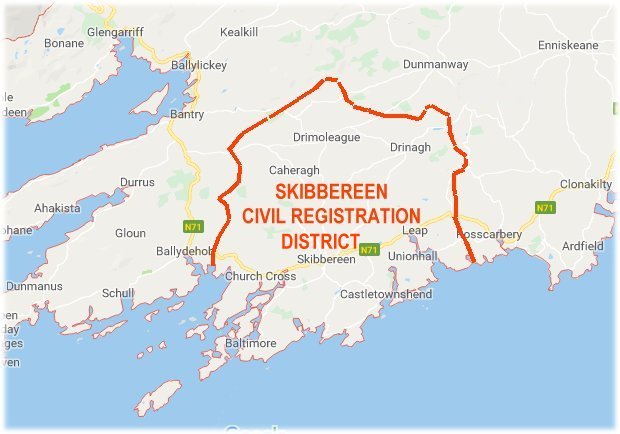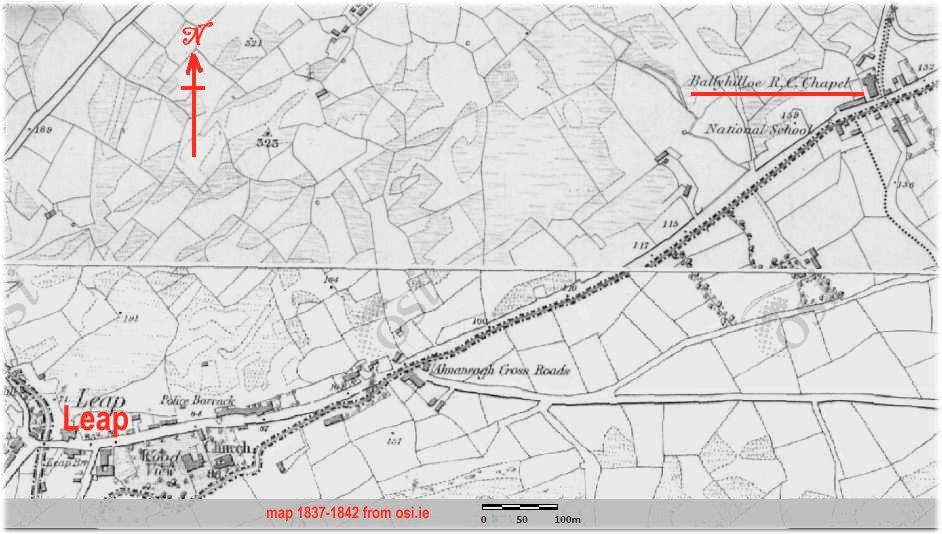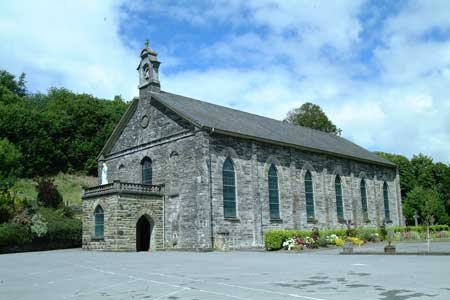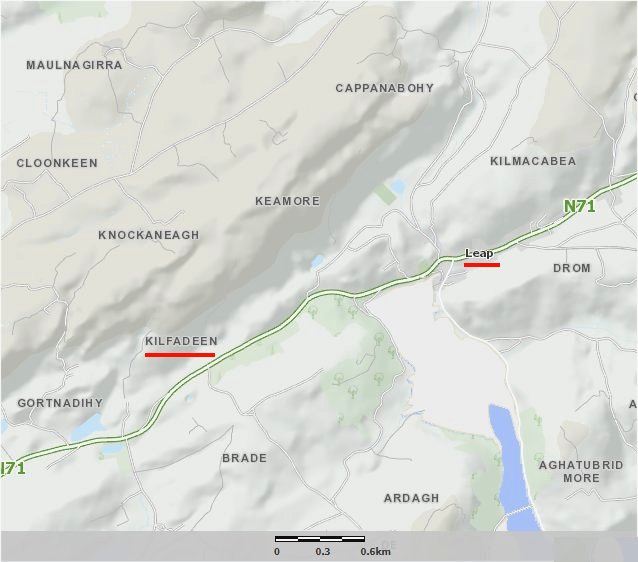DONOVAN surname: The Donovans or O'Donovans came from the Bruree region of County Limerick where in early christian times this was the territory of Uí Fidgente. These were divided into two branches, viz. Uí Chairpri in the East and Uí Chonaill Gabhra to the West. As a result of ongoing feuds they were driven from there by the O'Briens about 1178. The O'Donovans eventually settled in West Cork in the Glandore - Rosscarbery region and soon the Uí Chairpri name was given to the large region today known as Carbery.
BURKE surname: The first person of the name to arrive in Ireland was William Fitzadelm de Burgo, a Norman knight from Burgh in Suffolk, who took part in the invasion of 1171, and succeeded Strongbow as Chief Governor. Variants of the Burke name include Bourke, de Burgo, Burgh, and De Burgh, and the Gaelic name de Búrca.
Leap or its Irish name, Léim Uí Dhonnabháin means "O'Donovan's Leap" and is derived from the story of a local chieftain called O'Donovan, who was pursued by enemies, but escaped them by jumping across a ravine at the bottom of the village, thus the name. It lies in the Parish of Kilmacabea.
From A Topographical Dictionary of Ireland, 1837 by Samuel Lewis we quote what he says about Kilmacabea
"KILMACABEA, a parish, partly in the Eastern Division of the barony of WEST CARBERY, but chiefly in the West Division of that of EAST CARBERY, county of CORK, and province of MUNSTER, 11 ½ miles (W.) from Clonakilty, on the road from Cork to Skibbereen; containing 5800 inhabitants. It is situated at the head of Glendore harbour, and comprises 11,559 statute acres, as applotted under the tithe act, and valued at £3965 per annum: there are about 100 acres of plantations and 1400 of bog, besides several small lakes. The land is generally rocky; about two-thirds are under tillage; but agriculture is in an unimproved state. The substratum is clay-slate, with some calcareous schist and magnesian limestone. It is a vicarage, in the diocese of Ross, united to Kilfaughnabeg, and in the gift of the Bishop: the rectory is partly impropriate in the Gumbleton family, and partly united to those of Kilfaughnabeg, Kilcoe, Aghadown, Kilcaskin, and part of Tullagh, which form the corps of the archdeaconry of Ross, also in the patronage of the Bishop.
The tithes amount to £590, of which £99. 5. 6. is payable to the impropriator, £195. 14. 6. to the archdeacon, and £295 to the vicar; the entire tithes of the vicarial union amount to £435, and of the corps of the archdeaconry to £774.16. 9. The church, which is a handsome building with a lofty square tower, in the village of Leap, was erected in 1827, at an expense of £900, which was granted by the late Board of First Fruits. There is a handsome glebe-house, with a glebe of 8a. 10p.
In the R. C. divisions it is the head of a union or district, comprising also Kilfaughnabeg, and has a large and commodious chapel at Leap. The parochial school is endowed with an acre of land by the late General O'Donovan, and there are three other public schools, in which about 620 children are educated, also a Sunday school supported by the rector and curate. The ruins of the old church are near the village of Leap, the neighbourhood of which is very romantic and beautiful."
Leap lies within the Civil Registration District of Skibbereen. Clearly this includes several communities and small towns so refining a location to the more local area is essential.

Birth, marriage and death records were only recorded by the State from 1864 to date. So no such records before 1864 are available from Government sources. For data pre 1864 we have to rely on Church baptismal records and Church marriage records. These are only available from 1832 onwards for the Catholic Parish of Kilmacabea. So we do not have any records of births or marriages for this area prior to 1832.
The Catholic Church for Leap in the early 1800's was about a mile to the NE of the village.

The current church was built in 1848 according to the Church records

Kilmacabea Catholic Parish Church, Leap.
Joseph Donovan and Mary Burke married but the record is not available as it predates available records for Kilmacabea Catholic Parish which commence in mid 1832.
Children included:
Jeremiah Donovan, c 1823
James Donovan, c. 1830
John Donovan, c. 1833
Daniel Donovan, born at Keelfadeen and baptised on 9 Jan 1841 in Kilmacabea Catholic Parish. Sponsors: Daniel Burke, Kate Dineen
Death of Joseph:
Joseph Donovan died at Kilfadeen, Leap on 27 January 1866. From his death record he was married, aged 71 years. The Informant of the death to the Civil Registrar was Daniel Donovan, Kielfadeen.

It is not uncommon in the records to see several variations in the spelling of any particular townland address. Frequently it was written based on the local pronunciation. The official spelling is Kilfadeen as on the location map below from osi.ie

Family Heritage - Ancestry - Genealogy
By Thomas J Donovan
"PART 1 -
Where does the information comes from?
Federal Census - the US census is conducted every 10 years and becomes public after 72 years. The early censuses in the 1800s did not contain much information, generally just a list of names in a town. The 1890 census was destroyed. The censuses in the early 1900s contained names, family relationships, ages, occupations and other useful data. The next release will be the 1950 census in 2022. Interesting: Canadian censuses are released after 92 years.
State and local birth, marriage and death records. Once we get into 1900s, only the indexes are available. In those cases one would have to buy copies of the actual record from the government entity.
Draft records and military records. Unfortunately a fire in 1973 destroyed many military records.
City Directories. These town directories were created as an advertising medium. Contained residences and occupations. From the 1800s to mid 1900s.
Other Sources: Real estate ownership records - Mostly from various Massachusetts Registry of Deeds. Immigration Records. Naturalization (citizenship) Records. Newspapers, e.g. Boston Globe. Probate Records (Wills). Education records. Cemetery records and Find a Grave database records.
In Ireland many government records were destroyed in a fire in 1922. One needs to rely on local church records or other local sources.
In addition, personal family information and pictures. If you have any information or pictures on our ancestors, please pass it on. Also, information on ourselves. If you are looking for more in-depth info on anyone, please let me know. Note: records of people that are alive are hidden while those who have left us are available to others on Ancestry.com "
Above we have read PART 1 of the family story by Thomas J. Donovan. On additional pages linked from this page Thomas has contributed very significantly to the Donovan genealogy. Indeed a huge debt of gratitude is due to Thomas and very well deserved. Below is his closing part on the current available information on the extended family. As he states corrections etc are welcome. Many of us strive to have accurate information on our ancestors; unfortunately at time we hit brick walls but it is far better to stop at the wall rather than "moving it a bit", so to speak, and invent. This approach of course is misleading to other researches - but such is genealogy!
PART 15 -"Epilogue.
We have covered the Donovan Clan. We started out by going back in time on our direct line to Joseph Donovan and Mary Burke, West Cork. Then, four sons were identified - Jeremiah, James, John, and Daniel. There is a possibility that additional sons and daughters may have existed. Records in Ireland and the U.S. are not the best, especially when looking back in the 1800s. In Ireland and in the United States, there are not a lot of records that capture children information.
We have come a long way and our heritage mirrors the population in general. Jeremiah Donovan and Margaret Hurley had 11 children while living in Brookline, Massachusetts. Only two children survived to full adult age. In the time of the late 1800s to the early to mid 1900 there were no effective medicine. Penicillin, an early modern drug, was discovered in 1928 but not widely used until the Second World War. Prior to the mid 1900s, there was not much medicine available if you became sick. Today, with the discovery of many modern drugs and application of modern medical practices, we no longer have high infant mortality rates. Also, back in time, a Donovan at age 70 lived a full life. Today 80s to 90s are the norm.
Our great-great grandfather, Joseph, died about the age of 70, in Kilfadeen, Ireland. As described in his death record, "a poor blind man". The Great Hunger of the mid 1800s, left the Irish with poor diets which would reflect on one's health. It is estimated that over one million died of hunger and disease, while another million emigrated to other countries. Skibbereen area, West Cork was one of the worst areas hit by the potato famine.
The first generation of Donovan brothers in Brookline could not read or write. The boys signed their names with an X. The most common occupation was laborer. The immigrants were useful in the growth of America. There was a great need of physical labor to build roads, canals and railroads. In the next generation, we find Donovans still in blue collar occupations, but less brute force jobs with a level of skill; switchmen in railroads, firemen, plumbers, etc. In the following generations and today we find highly regarded professionals: doctors, lawyers, engineers, business executives, along with skilled craftsmen.
The Donovan family from Brookline grew over the generations. What started out as four families with twenty-five children, has grown to 700 people. That number includes the Donovans from Union Hall, who may not be directly related. Our Ancestry.com database includes family out to third cousins and spouses. For a few of the spouses (married to Donovans) we have included their families. Also included are 33 portrait photos.
So the major discovery work of the Donovans from Brookline ancestry is complete. From time to time, when new information presents itself, individual histories will be updated.
For now, if anyone has more information to share, it would be appreciated. Information would include birth, marriage, education, employment, residences and any else that you feel relevant to memorialize our relatives or update information on the current generation. Portrait pictures would be welcome. Also, most important, any corrections to the information presented.
As to information placed in Ancestry.com, for the dearly departed, the information is available to anyone that is a subscriber to Ancestry. For the rest of us, the records are restricted to only the owner of the database and those that are specifically given access to the Donovan Family Tree.
Our family members have been memorialized back in County Cork. The web site is bmdnotices.com, Birth-Marriage-Death and Life In Between. You can enter from the main page or here is the link to our grandparents, Joseph Donovan and Katherine Flaherty: http://bmdnotices.com/remembrance-garden-book/viewremembrance.aspx?remembranceid=1858 The web site is the result of the hard work of Frank O'Donovan, of Bantry.
Summary of the parts:
Part 1 General Information and Joseph Donovan - Mary Burke
Part 2 Jeremiah, James and John Donovan
Part 3 Daniel Donovan - Elizabeth Gallagher
Part 4 Jeremiah Donovan - family
Part 5 Jeremiah Donovan - family
Part 6 James Donovan - family
Part 7 James Donovan - family
Part 8 James Donovan - tree
Part 9 John Donovan - family
Part 10 John Donovan - tree
Part 11 Daniel Donovan - family
Part 12 Daniel Donovan - family
Part 13 Daniel Donovan - tree
Part 14 Donovans from Union Hall
Part 15 Epilogue."